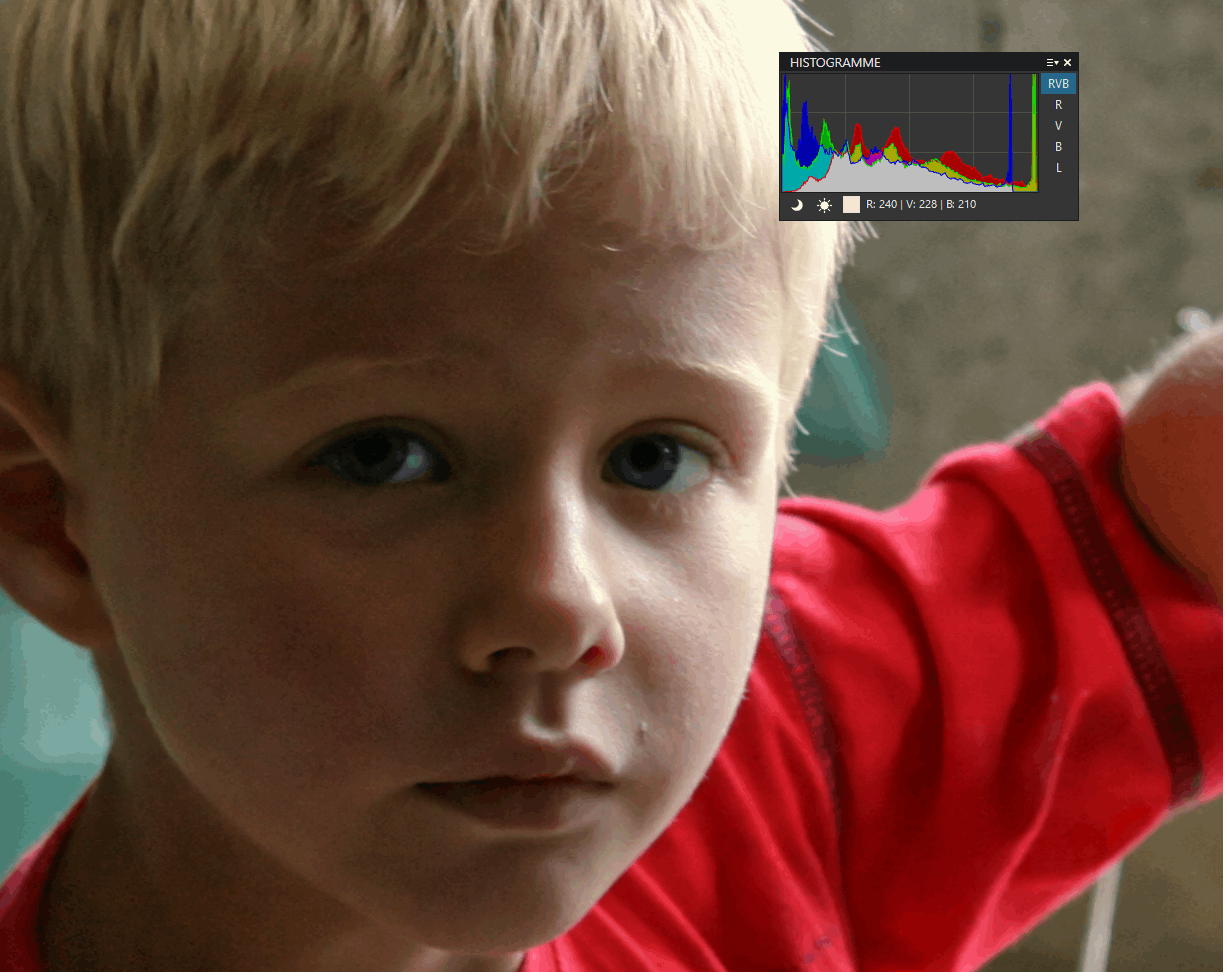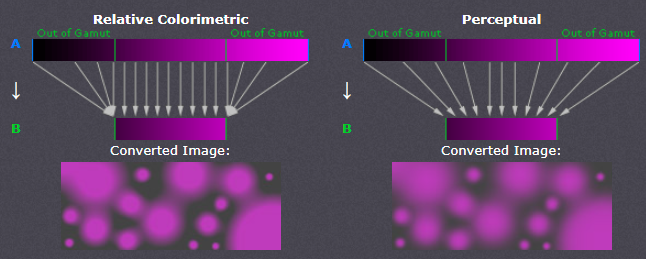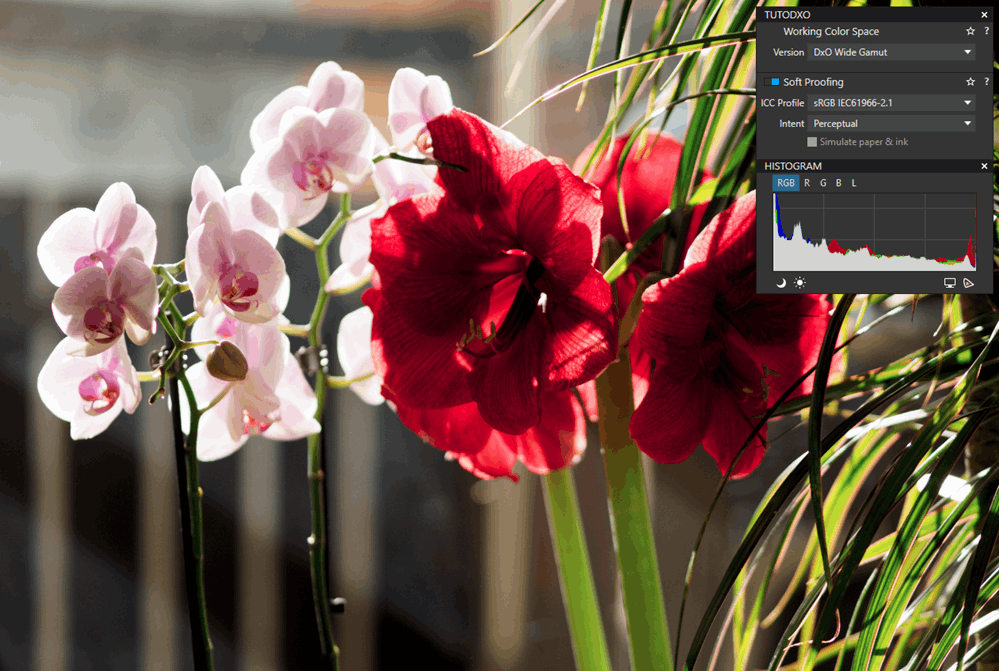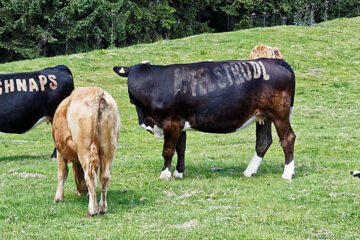Sommaire
The Histogram
Like other software, PhotoLab’s histogram presents the processed version (current display) of the image according to an 8-bit scale (JPEG compatible), either on 255 values, considering the latter as the “100% brightness” .
At the heart of the software, the decomposition of values is far superior, the maximum brightness is on the 65,536 th section.
* Highlight (Ctrl+ W/A) and Dark Tone (Ctrl+ B/B) clipping alarms can be swapped.
* The height of the histogram palette can be changed by clicking and holding the lower part of the histogram (Windows only).
The histogram warnings are basic. If a single channel is clipped, the pixel is displayed according to its reverse color.
The black and white pixels warn of real clipping (on all 3 channels).
* The raw histogram with its large dynamic range is not accessible. A warning in reverse tone, all black or white (all RGB channels at 0 or 255) does not necessarily mean that there is clipping when shooting, only that there may be clipping.
I asked DxO to create a raw input data overexposure warning button. A color effect would indicate areas on the image that are irreparably lost.

The colored warnings on this image are mean that some channels are saturated but these pixels are not clipped.
The warnings must be put into perspective, especially for a color channel at 0.

The warnings must be put into perspective, especially for a color channel at 0.
There are false warnings in this photo.
1- Lack of green and blue on a red shirt
2- Lack of blue on the ear! My boy is not a Smurfs 😉
BEWARE. The warnings cover the entire content of the image, including the frame and the signature (watermark).
The Soft Proofing
The Soft Proofing is an optional step to be included in the flow before exporting the images where the colors must be returned with precision.
DxO recommends doing this action on a virtual copy. Indeed, the resulting image may be different according to its destination (web display or particular type of screen, particularities of the paper) expressed by the export profile; sRGB, Display P3 or a printer profile.
It is important to keep in mind that color shades that are not faithfully reproduced are not necessarily fancy but rather indiscriminate. Perhaps it may involve changing the contrast or saturation to recreate this distinction if it is important.
The Soft Proofing is activated in the palette Color (Elite edition only).
The background color a little too light can be modified in the preferences.
– Preferences / Display / Soft Proofing Color
The Soft Proofing is used in two times.
– Define the ICC profile in the palette “Screen proofing”
– At the time of export, indicate the ICC profile “Same as Soft Proofing”
To avoid confusion (is this ICC profile “sRGB” the “common” profile or a custom version of DxO), DxO decided to use the full name of the standard; sRGB IEC61966-2.1.
Standard color spaces are proposed.
– sRGB IEC61966-2.1 is the most common diffusion profile
– Display P3 is the new wide color space that will replace sRGB
– Display and printer profiles must be imported
PhotoLab will look for the profiles in the system folder.
In order not to lose them when changing computer, it can be judicious to deposit them with the DxO folders.
Create %LocalAppData%\DxO\DxO PhotoLab 6\Profiles
Conversion Intent refers to the way PhotoLab distributes out-of-range colors in the image.
* The Perceptual mode maintains color gradients by compressing the image over the entire available tonal range. This is the preferred mode.
* The Relative mode maintains exactly the colors available in the gamut by reducing out-of-gamut colors to their maximum saturation.

Histogram warnings are reviewed.
– Shadow clipping (Ctrl+ Alt+ B/B)
– Highlight clipping (Ctrl+ Alt+ W/A)
– Monitor gamut warning (Ctrl+ Alt+ M/?)
– Destination gamut warning (Ctrl+ Alt+ D/?)
– CMYK warnings of an Offset printer

The histogram provides buttons for warnings of out-of-gamut pixels, both for the current screen (permanent) and for the color profile for which the soft proof is set.
This mode allows you to identify colors that are in PhotoLab’s working color space but that your monitor, or paper intended for printing (available soon), cannot display faithfully.
The choice of the warning colors is not judicious, especially in red (color profile), a color difficult to render correctly that blends with the reds of the image. A gray warning would have been more relevant.
Monitor Gamut Warning (when Soft-Proofing is off) shows colors that the screen cannot reproduce.
To determine them, DxO compares the colors of the working color space with the color space of the screen, that is, the color profile of the operating system.
Destination Gamut Warning (can only be activated in Soft-Proofing mode) shows the colors that cannot be reproduced by the ICC profile.
When using a CMYK profile, the histogram displays these four channels instead of the RGB channels
Monitor Gamut Warning (when soft proofing is activated) shows the colors which can be reproduced by the ICC profile but cannot be displayed by the screen as well the colors which can not be reproduced neither by the ICC profile nor by the screen
These warnings indicate colors that are unreliable.

According to DxO
Most modern printers are able to reproduce a wide gamut like Adobe RGB (1998) and even more.
Working in the widest possible gamut is always better, it’s just when exporting that you have to indicate in which color space the image should be converted.
All web content, and basically any application, uses sRGB IEC61966-2.1 which is considered the “starting point”. Any gamut above sRGB considered is a wide gamut.
Display P3 (based on DCI P3) is gaining ground and many displays on the market are capable of covering it (a cheap monitor is capable of reproducing 95%). It seems that Display P3 will replace sRGB in the near future for all online content.
Rec2020 and ProPhoto are the largest color spaces and it is always best to shrink at the end of the workflow.
Saving in 16-bit TIFF with these ICC profiles ensures that all color information is retained. Exported to Affinity or Photoshop, the rest of the treatment is done with the most precision and data possible.
NB. There is currently no monitor capable of fully covering the widest gamuts, such as rec.2020 and ProPhoto RGB.
TuToDxO.com – All rights reserved – tous droits réservés.



